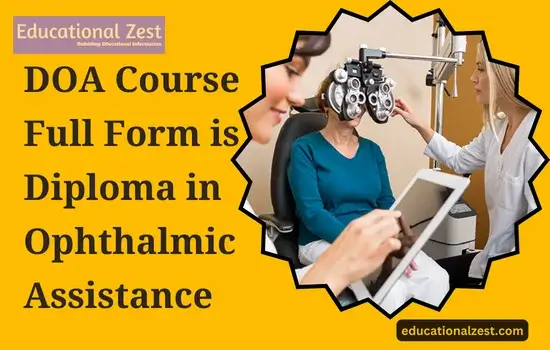The Doa Course Full Form is Diploma in ophthalmic assistance. Deciding to pursue a diploma in ophthalmic aid might be a fulfilling career decision if you have a strong interest in eye care and are passionate about healthcare. In hospitals and eye clinics, ophthalmic assistants are vital members of the medical staff who help ophthalmologists treat patients’ eyes. This article examines the field of ophthalmic aid, going into necessary training and education, work options, the advantages of earning a diploma, the necessary skills and credentials, and more.

What is the Course About?
Eye doctors use ophthalmic assistance to diagnose and treat eye disorders. You will assist ophthalmologists with eye examinations, collect patient medical information, do preliminary eye tests, and educate patients on eye care. This profession requires detail-orientedness, communication, and patient empathy. Most courses include eye anatomy and physiology, ophthalmic instruments and procedures, ocular problems, and patient care. The program involves real-world application training. This hands-on experience is crucial for patient involvement and eye exam skill. Ophthalmic aid diplomas may benefit future professionals. It makes graduates highly skilled in ocular surgeries, diagnostics, and patient care. Experience in practical training boosts students’ skills and confidence. An ophthalmic help certificate increases employability since employers prefer formal education. The intended curriculum keeps graduates current on eye care technology, making them valuable healthcare assets. Ophthalmic assistants use theory and practice to work effectively in healthcare.
Eligibility Criteria
To start this rewarding trip, candidates must qualify. Most Diploma in Ophthalmic Assistance programs accept Class 10th or 12th graduates. Students must learn basic science and arithmetic to understand eye care.
Future Scope
Eye care should increase in the next years. Ophthalmology is in demand owing to technology and aging. This growth gives skilled workers several possibilities. An ophthalmic assistant degree today might lead to a rewarding profession. Healthcare professionals like ophthalmic assistants are in demand as the industry grows. Eye care experts must be current on diagnostic and treatment methods. Ophthalmic assistants will be essential to meeting these emerging healthcare requirements. Ophthalmic assistants have several employment choices owing to increased eye care demand. Eye clinics, hospitals, optical centers, and research institutions recruit graduates. Ophthalmic assistants help ophthalmologists, optometrists, pediatric, and retinal specialists. Diverse fields allow for growth and specialization. Eye clinics need ophthalmic assistants. They help with examinations, educate patients about eye health, manage accurate records, and make patients feel comfortable.
Salary
Ophthalmic assistants must consider finances. Ophthalmic assistants in India average Rs 317,000. Geography, experience, and healthcare facility type impact pay. TOP ophthalmic aid recruiters include Indian Red Cross Society, Indian Nursing Council, Kailash Hospital, Metro Hospital, Max Hospital, AIIMS, and Fortis Hospital. These companies value skilled ophthalmic assistants’ superior eye treatment and aggressively recruit diploma holders.